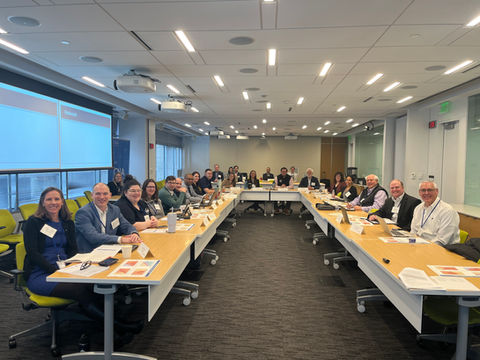
02 Training
Tell me and I forget, teach me and I may remember, involve me and I learn. - Benjamin Franklin
Our team of Master Exercise Practitioners, fire service/EMS/public health instructors, and subject matter experts have delivered every type of educational opportunity imaginable to audiences ranging from children in grade school to senior elected officials. Our methods are flexible; we have delivered courses that must meet strict guidelines, such as FEMA’s Incident Command System courses and custom courses designed to meet a unique need. We utilize the National Standard Exercise Curriculum (NSEC), as the foundation of our training program, and would build upon that to meet Amtrak’s specific strategic and operational needs.
Training Standards: Perses Consulting follows the FEMA Emergency Management Institute’s (EMI) training standards and the National Standard Exercise Curriculum (NSEC), which fosters an integrated and systematic approach for building and delivering educational capacity across the whole community and all five mission areas. Following these standards, Perses Consulting will work with the Amtrak project team to incorporate four guiding principles into all training programs:
Collect and analyze data on training and education requirements and use that analysis to inform decisions on funding, programming, and course design and delivery;
Promote individual competency areas to build workforce capacity and ensure continual development of education programming;
Use training and education to build and sustain capabilities that address a community or organization’s priority threats and hazards; and
Coordinate and collaborate across the whole community to build “Communities of Practice” that share information and resources to address training and education requirements. Through these principles, Perses Consulting will help Amtrak translate training and education needs into viable courses of action that produce successful outcomes and strengthen public health preparedness.
Training Development Process: Perses Consulting incorporates the ADDIE Model in all its training projects. ADDIE is an instructional systems design (ISD) framework that many instructional designers and training developers use to develop courses. The name is an acronym for the five phases it defines for building training and performance support tools: Analysis, Design, Development, Implementation and Evaluation.
Analysis: Perses Consulting works with its clients to clarify the instructional needs and objectives, and identify the learning environment and learner's existing knowledge and skills. Clarifying the instructional scope is often part of a needs analysis and helps determine constraints and resources in order to fine tune the Plan of Instruction (POI). Perses Consulting models its POI off the FEMA EMI POI template.
Design: Perses Consulting works with its clients to further develop learning objectives, assessment instruments, content, subject matter analysis, lesson planning and media selection. The design phase is systematic and specific. Perses Consulting follows the following steps for the design phase:
Documentation of the project’s instructional, visual and technical design strategy;
Apply instructional strategies according to the intended behavioral outcomes by domain (cognitive, affective, psychomotor);
Create storyboards - Design the user interface and user experience;
Prototype creation; and,
Apply visual and graphic design.
Development: The purpose of this phase is to generate the lesson plans and lesson materials. During this phase Perses Consulting works with its clients to develop the instruction, all media, and any supporting documentation. Consultants, trainers, and subject matter experts create and assemble the content assets that were created in the design phase. Perses Consulting uses Articulate 360 to develop all online training content. Articulate 360 is a holistic suite of interconnected apps for all training needs—from training development and authoring (Rise 360, Replay, and Peek 360) to sourcing assets (Content Library 360) to collaborating (Review 360) to training (Articulate 360 Training).
Implementation: Perses Consulting works with its clients to develop a procedure for training the facilitators and the learners. The facilitators’ training (also known as a Train-the-Trainer session) covers the course curriculum, learning outcomes, method of delivery, and testing procedures. We typically propose conducting an initial pilot of each training program. Through this pilot process, we gather participant feedback to adapt and improve the training program. The training pilot should be scheduled with enough time to make necessary changes prior to the next training date.
Evaluation: This phase consists of two parts: formative and summative. Formative evaluation is present in each stage of the ADDIE process, and ensures constant, consistent feedback and evaluation is fed into revisions and content alterations. Summative evaluation consists of tests designed for domain specific criterion-related referenced items and providing opportunities for feedback from the users. As outlined throughout this approach, Perses Consulting requests feedback and continuously monitors training program development and implementation to pinpoint strengths and weaknesses and make program improvements. Our team understands that the process of curriculum development is fluid and throughout the engagement our team would continue to assess, review, and modify the curriculum and training materials, as necessary, to meet the training needs of of our clients.
Throughout each phase of the ADDIE process we involve key stakeholders, SMEs, and other pertinent individuals and groups to ensure the training curriculum is aligned with programmatic goals, leadership intent, best practices, and other needs to the specific engagement. The training products developed must pass stakeholder review prior to moving forward to the next step in the process. We pride ourselves on making the review process as simple as possible, to not over-inundate individuals with review responsibilities.
Power in Numbers
30
Programs
50
Locations
200
Volunteers



